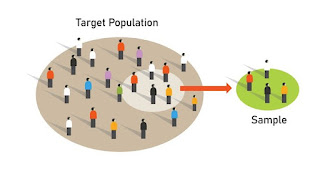SAMPLE DESIGN
Sample Design
A sample design is a definite plan for obtaining a sample from a given
population It refers to the procedure, adopted by a
researcher for selecting items for a sample. Sample design suggests how many
items are to be included in the sample It gives an idea about
the size of the sample. There are many sample designs. A researcher can choose
the appropriate design.
Different
Methods for Selecting Samples (Sample Designs)
Various methods available for selecting samples
can be grouped under two major heads
(1)
Random sampling
(2) Non
random sampling
Probability Sampling (Random Sampling)
Each
person in the population has equal, independent, and known chances of being
selected.
Probability
sampling may be simple random sampling and complex random sampling.
stratified
sampling, systematic sampling and cluster sampling are known as complex random
sampling.
Simple Random Sampling
A simple random sample is a sample selected
from a population in such a way that every member of the population has an
equal chance of being selected and the selection of any individual does not
influence the selection of any other
Random samples may be selected
• by Lottery method
• from table of random numbers
Lottery Method. Under this method, all items of the universe
are numbered or named on separate slips of paper of identical size and shape.
This slips are then folded and mixed up in a container. A blind fold selection
is then made of the number of slips required to constitute the desired size of
the sample. While preparing slips it must be seen that slips are of identical
size, shape, colour etc. Otherwise there is a possibility of selecting a
particular slip.
Table of Random Numbers
Several standard tables of random
numbers are available (1) Tippets random number tapes (2) Fisher and yate’s
tables etc. Tippets table of random numbers contains series of random digits
arranged in rows and columns. These tables are used for getting random numbers
corresponding to which we select items from population.
Merits and Demerits of Simple Random Sampling
• Merits
• There
is no possibility of personal bias
• The
simple random sample usually represents population particularly when the sample
size is large
• Demerits
• It
is often difficult to have an up to date list of all items of the population to
be sampled
• If
the size of the sample selected is small, the results may not be reliable
Stratified Sampling
In this method divide the population into
different sub population known as strata, such that items in each stratum are
homogeneous. From each stratum, items are selected by simple random sample
method. Stratified sampling method reduces time and expense to a greater
extent.
Kinds of
stratified sampling
(1) Proportional
stratified sample
(2) Disproportionate
stratified sampling
(3) Stratified
weighted sampling
Proportional
stratified sampling. Where number of items taken from each
stratum is on the basis of size of each stratum.
|
||||||||||
|

Comments
Post a Comment